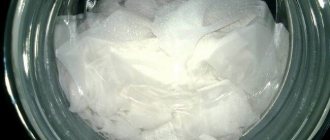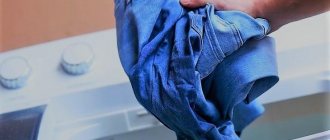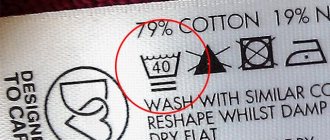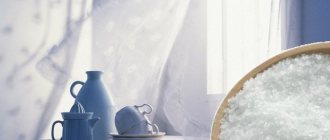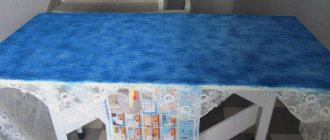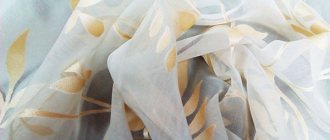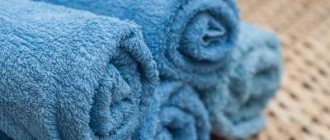Light, translucent, airy curtains on the windows help create a special atmosphere of home comfort and tranquility.
But, unfortunately, initially snow-white tulle under the influence of bright sunlight and dust takes on the gray, worn look of an old thing.
Some tips and recommendations will help restore the original whiteness and refresh the tulle.
We will tell you in the article how to wash tulle so that it is snow-white, and how to get rid of gray and yellow tint at home.
Folk remedies for getting rid of grayness and yellowness at home
Traditional methods of bleaching, proven over the years, will help you quickly get rid of stains, yellowness, and restore the freshness and cleanliness of the curtains on the window.
Salt
Soaking in a saline solution will help remove grease stains and restore the whiteness of curtains that have lost their appearance.
Algorithm of actions:
- In a ten-liter bucket of warm water, dilute half a glass of salt and the same amount of washing powder.
- The tulle is soaked in the resulting solution (for about twelve hours).
- Afterwards, the curtain is removed from the solution, allowed to drain and washed as usual.
For soaking, it is better to choose medium-sized, non-iodized salt.
Soda
Regular baking soda will quickly return a snow-white, shining look to old, washed curtains.
Algorithm of actions:
- dilute two tablespoons of baking soda and the same amount of washing powder in five liters of warm water;
- the curtains are soaked in the resulting solution and left to soak for twenty minutes;
- Afterwards the tulle is washed by hand or in a washing machine as usual.
Ammonia
A mixture of ammonia and hydrogen peroxide is an effective remedy in the fight against grayness and yellowness of washed curtains.
Algorithm of actions:
- 30 ml of ammonia and 60 ml of hydrogen peroxide are dissolved in five liters of warm water;
- The tulle is soaked in the solution and left for half an hour;
- Afterwards, the curtain is washed as usual.
If the tulle is very old, or there are stubborn stains on it, you can wash it in the following way:
- A bottle of ammonia is dissolved in a ten-liter bucket of warm water.
- The curtain is soaked in the resulting solution for at least twelve hours.
- Afterwards, the fabric is rinsed and sent to the wash.
This method helps to bleach tulle made of nylon, chiffon, and organza.
Zelenka
Strictly following the instructions for bleaching with brilliant green will help return organza or nylon curtains to their former whiteness.
Algorithm of actions:
- 10 drops of brilliant green and two tablespoons of table salt are diluted in 250 ml of clean water.
- Strain the resulting solution and add it to a ten-liter basin filled with warm water.
- The tulle is dipped into water with brilliant green and left for five to ten minutes.
- Without rinsing, the tulle is immediately hung out to dry on the ledge.
Using this method, it is very important to strictly adhere to the dosage of brilliant green. Otherwise the tulle will be damaged.
The video will show you how to bleach tulle with brilliant green:
Blue
Blue will help restore the shining whiteness of washed tulle.
Algorithm of actions:
- Add a cap of blue water to a bowl of warm water (at least ten liters).
- Already washed curtains are dipped into the resulting solution and left for ten to fifteen minutes.
- Afterwards the tulle is rinsed in clean water and hung out to dry.
When diluting blue in water, it is important not to overdo it with the dye. It is necessary to strictly adhere to the manufacturer’s recommendations, and also monitor the color saturation of the water.
Boric acid
Boric acid will help remove yellow plaque from a white window curtain.
Algorithm of actions:
- 60 ml of boric acid is dissolved in ten liters of warm water;
- soak the yellowed tulle in the resulting solution for at least two hours;
- Afterwards, the now white curtain is rinsed in clean water and hung to dry on the ledge.
Read about how to bleach tulle using salt, soda, vinegar and brilliant green in this article.
Methods for bleaching tulle from different types of fabrics
To create modern textiles, nylon, viscose, cotton or organza are used. The finished product takes the form of mesh or lace. To clean fabric from stains and yellowness, you can buy industrial preparations based on hydrogen peroxide. They remove yellowness, complex stains and get rid of grayness. It is enough to take the mixture according to the instructions and leave it to soak for a certain time. Liquid substances dissolve more easily and are easier to wash off from fabric.
To wash delicate curtains from stains and yellowness, it is better to use traditional methods:
- nylon - hydrogen peroxide, salt, or brilliant green;
- cotton - laundry soap and starch;
- organza - ammonia with hydrogen peroxide;
- flax - ammonia, or boiling with soap;
- veil - starch or ammonia.
Under no circumstances take chlorine-containing preparations for yellowness. They remove dirt, but destroy the fabric structure and thin the threads.
How to make fabric turn white using household chemicals?
Household chemicals will help quickly return tulle to its former shining whiteness. There are many advantages of this type of washing:
- bleaches remove any stains and dirt;
- washing with chemicals is easier, faster and more effective (folk remedies do not always help achieve the desired cleanliness effect).
When choosing chemicals for washing, you need to be prepared for the fact that the strong smell of the product can cause an attack of an allergic reaction.
It is strictly forbidden to bleach tulle with chlorine-containing compounds. After such washing, there is a high risk of final damage to the product.
The most acceptable option is oxygen-containing bleaches, which contain particles of hydrogen peroxide . It is they that dissolve upon contact with water, forming bubbles that remove particles of dirt and gray plaque from the fabric.
When washing by hand, oxygen-containing bleaches are dissolved in water (dosage specified by the manufacturer). Then the tulle is dipped into the resulting solution.
After half an hour or an hour, the curtain can be removed, rinsed and hung to dry . When machine washing, oxygen bleach is added to a special compartment of the machine along with the powder.
TOP 3 most popular and effective bleaches for tulle:
FRAU SCHMIDT SUPER WHITE TULLE is a product from a French manufacturer, available in tablet form.
The average price of a package (5 tablets) is 250 rubles. Dissolving in water (one tablet is enough for one wash), FRAU SCHMIDT removes any dirt from delicate fabric, while maintaining its structure.The product does not cause allegory, since when dissolved it does not emit any unpleasant odors.
- SPLASH FOR TULLE FROM GENERAL FRESH is an oxygen bleach from a Polish manufacturer. The product is in powder form, packaged in small 30 g bags. (enough for one wash). The average cost of a bag is 30 rubles. SPLASH FOR TULLE FROM GENERAL FRESH is ideal for curtains made of any type of fabric.
- Elixir for tulle and curtains “CASHMERE” is a product from a Russian manufacturer. Affordable (only 40 rubles per 300g), this effective product perfectly washes tulle from stains of any origin, removes unpleasant odors, and restores whiteness and freshness. Elixir for tulle and curtains “CASHMERE” is suitable for both hand and machine washing.
All the subtleties of ironing
Does tulle need to be ironed? Typically, synthetics straighten out on their own during drying. But if there is an ornament on it, and it has become deformed after washing, it is worth ironing the curtains while they are still damp. We do this exclusively through fabric (gauze). Using light sliding movements, set the iron to 110 degrees.
Expert advice
Natalia Prokofieva
Expert in the field of washing, cleaning, stain removal on various materials and surfaces
Ask a Question
You can also iron it with your hands. How to do it? We hang the tulle. We wet a small area of the curtains with water, you can spray it with a spray bottle. And then we simply iron the curtain on one side and the other with our hands.
Which is better - in the washing machine or by hand?
When choosing between machine and hand washing, you first need to decide on the type of fabric. Not all types of tulle are machine washable.
For example, delicate organza or natural silk curtains are best washed by hand. Detailed information about the composition of the fabric and washing methods should be clarified in advance.
Regardless of whether hand or machine washing is intended, to achieve the best result, the curtain must be properly prepared:
carefully remove the curtains from the windows, shake them from dust (it is better to carry out such manipulations on the balcony or street);- fill the basin with cool water (temperature no more than 30C), add a few tablespoons of ordinary table salt;
- soak the tulle in salted water for thirty to forty minutes;
- take out the curtain, let the water drain, and begin the main wash.
Do not use iodized salt to prepare a saline solution for soaking.
Manually
You can achieve an ideal washing result only if you follow a certain sequence of actions:
- You need to fill a basin (or better yet, a bathtub) with lukewarm water (temperature no higher than 40C) and add detergent.
- Having loaded the prepared tulle into the soap solution, leave it alone for a few minutes, after which we wash it with gentle squeezing movements.
- Rinse the washed product thoroughly (it is better to change the water two to three times).
- Dry the light tulle on the curtain rod, after waiting a while for the excess water to drain off. If after drying there are creases and folds left on the tulle, you can simply remove them using an iron with a steam function.
If there are complex, old stains on the curtain, you need to get rid of them before starting the main wash. Otherwise, it will not be possible to achieve the ideal result of cleanliness and freshness.
In automatic mode
Only if you follow the clear recommendations for machine washing can you preserve the structure of delicate fabric and achieve the ideal result of a snow-white curtain:
The prepared curtain (cleaned of dust, soaked in a saline solution) is loaded into a special bag (a cotton pillowcase is suitable), and only then into the drum of the washing machine.- Liquid detergent for delicate fabrics is poured into a special compartment of the washing machine, and oxygen bleach is added separately if necessary.
- The desired temperature mode is set (30-40C), as well as a washing mode for delicate fabrics. Spin speed does not exceed 400.
- At the end of washing, the curtains are immediately removed from the washing drum and hung on the curtain rod to dry.
It is strictly forbidden to use chlorine-containing laundry detergents. Chlorine not only disrupts the structure of thin fabric, but can also cause a very unsightly yellowish tint to appear.
Solutions that can be used for soaking
Saline solution is classified as effective and affordable. But in addition to salt, other products available in every home can be used to prepare a working solution. For example, soda. Soda solution is prepared from 2 tbsp. l. sodium bicarbonate, 50 g of washing powder and 10 liters of warm water. The tulle should be placed in this solution for half an hour. Wash – hand or machine.
There is an opinion that soda ash (caustic) also copes well with the tasks. But it cannot be used on delicate fabrics. The only material that can withstand the effects of this substance is natural cotton or linen. Nowadays, such tulle is rare, so you should not experiment with caustic.
Features of bleaching depending on the material
Achieving the ideal washing result - snow-white tulle - is possible only if the detergent and cleaning method are correctly selected for each type of fabric.
From nylon
Any detergents and folk remedies can quickly return nylon to its freshness and snow-white appearance. Only powders containing chlorine and bleaching components are prohibited .
Wash nylon tulle in water whose temperature does not exceed 30C. Machine wash only in delicate mode, at speed no more than 400.
A nylon curtain can be washed faster if it is pre-soaked in salted water.
From organza
Light, delicate organza is best washed by hand using liquid detergent. Under no circumstances should organza be rubbed, twisted, or stretched too much .
The water temperature for washing is not higher than 30C. Boiling organza and using chemical bleaches is strictly prohibited.
Laundry soap will help quickly whiten organza curtains, and rinsing in water with the addition of ammonia or hydrogen peroxide will consolidate the positive results of washing.
From the veil
The light, airy veil is washed only in cool water (temperature no higher than 40C), without using any aggressive detergents.
If machine washing is to be done, the tulle from the veil is loaded into a drum in a special case (you can use a cotton pillowcase). It is strictly forbidden to boil or twist the veil.
Washing tulle with hooks
If tulle curtains are decorated with additional decorative elements and are not cheap, then it is recommended to have them dry cleaned. But the presence of hooks is not an obstacle to self-washing.
If the eyelets and hooks are removable, then to make the task easier, they need to be removed. If the elements are non-removable, then washing in an automatic machine is possible only when using a bag. Its presence is necessary, because during rotation in the drum the hooks can damage the material.
Regardless of the type of fabric, tulle curtains with hooks are washed on a delicate cycle without spinning. The optimal temperature is 30-40 degrees. If the tulle is heavily soiled, it is recommended to soak it in cold salt water for several hours before washing.
Adviсe
When bleaching tulle, you should adhere to the following recommendations:
Tulle is washed only in warm water (not higher than 40C). Otherwise, you won’t be able to achieve radiant white results.- Grease stains and soot marks on nylon curtains can be easily removed with liquid dishwashing detergents.
- I wash delicate muslin and chiffon only in special bags.
- Wet tulle is never twisted or pulled out. Inaccurate sharp actions can cause fabric deformation, creases and folds.
- Tulle is never washed with other things.
